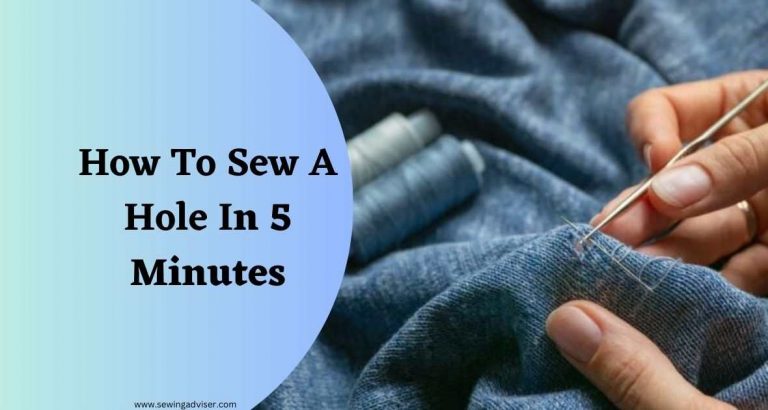How To Wash Cotton Fabric Before Sewing: 2024 Easy Hacks
Cotton is a natural fiber that is used to make a variety of different fabrics. It is important to know how to wash cotton fabric before sewing to remove any impurities or treatments that may be on the fabric. Washing also shrinks the fabric, which can help you achieve a better fit for your garment.
There are a few different ways that you can wash the cotton fabric before sewing. You can wash it by hand, in a washing machine, or using a steamer. It is important to read the care label on your fabric before washing it to ensure that you are using the proper method.
3 Best Ways To Wash Cotton Fabric Before Sewing
Hand Washing
Hand washing is the best way to wash delicate cotton fabrics. Fill a sink or basin with lukewarm water and add a mild detergent. Submerge the fabric in the water and swish it around gently. Allow the fabric to soak for 10-15 minutes before rinsing it with cold water. Gently squeeze the excess water from the fabric and lay it flat to dry.
Machine Washing
Machine washing is a good option for most types of cotton fabrics. Set your machine to the “gentle” or “delicate” cycle and use cold water. Add a mild detergent to the machine and run it through a full cycle. Remove the fabric from the machine and hang it up to dry or lay it flat on a towel to air dry.
Steaming
Steaming is another good option for washing cotton fabric before sewing. Fill a steamer with water and turn it on to heat up. Hold the fabric over the steamer and allow the steam to penetrate it for 3-5 minutes.
You can also place the fabric on an ironing board and steam it from underneath using an iron set on the steam setting. Once you are finished steaming, hang the fabric up to dry or lay it flat on a towel
Why Is It Important To Wash Your Fabric?
Cotton is a natural fiber and it will absorb dyes, oils, and perspiration from your skin. When you wash your fabric before sewing, it will remove any finishes that the manufacturer has applied to the fabric. This will prevent the fabric from bleeding and fading when you wash your garment.
To Remove Any Sizing
Sizing is a starch or gel that is applied to fabrics to give them body or stiffness. It is applied during the manufacturing process and often inhibits dyes from penetrating the fabric evenly. It can also make fabrics less absorbent.
Before you wash your fabric, you should check the selvedge (or self-finish) for any indications that sizing has been used.
You can do this by wetting a small area of the selvedge and rubbing it between your fingers. If the fabric feels stiff or sticky, it probably contains sizing that needs to be removed.
The easiest way to remove sizing is to soak the fabric in warm water with a mild detergent for 30 minutes.
You can then rinse the fabric in cool water and proceed with washing it according to the care instructions.
To Remove Any Dirt Or Impurities
It is important to wash your fabric before you begin sewing for a few reasons. Firstly, it is important to pre-wash your fabric because freshly dyed fabrics can leak dye when you first wash them.
This can ruin your finished garment or any other garments that it is washed with. Secondly, you want to wash your fabric to remove any dirt or impurities that may be on the fabric.
This step is especially important if you are working with natural fibers like cotton or linen. Lastly, washing your fabric will help to preshrink it so that your finished garment will not shrink when you wash it later on.
To Prevent The Fabric From Shrinking
It’s important to wash your fabric before you start sewing, especially if it’s the first time you’re working with it.
Washing will remove any finishes that were applied at the mill, and it will also shrink the fabric so that you can be sure it won’t shrink later when you wash your finished garment.
If you don’t wash your fabric before sewing, you run the risk of your garment shrinking when you do eventually wash it.
That can cause problems with fit, and it can also make your garment look misshapen and less than professional.
In some cases, it can even cause the fabric to break down prematurely. Washing your fabric before sewing is therefore an important step in the sewing process and one that should not be skipped.
How To Wash Cotton Fabric Before Sewing
Cotton is a natural fiber and one of the most popular fabrics used in quilting. It is important to wash your fabric before you sew with it, especially if it is going to be a gift or something you plan to keep for a long time.
Washing your fabric will also help to Preshrink it so that it doesn’t shrink when you wash your finished product.
Related Article: Can You Spray Paint Fabric
Fill a Sink Or Basin With Lukewarm Water
Fill a sink or basin with lukewarm water and add a small amount of mild detergent. Do not use bleach, fabric softener, or other additives.
Gently agitate the fabric in the water to loosen any dirt or debris. Let the fabric soak for 5-10 minutes.
After soaking, gently squeeze the fabric to remove excess water and rinse with clean, lukewarm water.
If necessary, repeat steps 2-4 until the fabric is clean.
Once the fabric is clean, gently squeeze or blot it to remove excess moisture. Lay the damp fabric on a flat surface and allow it to air dry completely before sewing.
Add a Mild Detergent
Cotton is a natural fiber that is used in a variety of fabrics. It is usually pre-washed before being used in clothing, but you may want to wash it again before sewing.
Washing cotton fabric before sewing helps to remove any impurities or finishes that may be on the fabric.
It also helps to preshrink the fabric so that it will not shrink when you wash the finished garment.
To wash the cotton fabric, start by adding a mild detergent to a washing machine set to the delicate cycle.
Then, add your fabric and let the machine run through its cycle. Once the cycle is finished, remove your fabric from the machine and hang it up to air dry. You can also put it in the dryer on low heat if you’re in a hurry.
Gently Agitate The Fabric
To pre-wash your fabric before sewing, start by gently agitating it in lukewarm water. You can do this in a sink or a washing machine set to the gentle cycle. Avoid using hot water or rough agitation, as this can damage the fabric fibers.
Once the fabric is wet, add a mild detergent and continue agitating gently until the detergent is fully dissolved. Then, let the fabric soak for 15-30 minutes to allow the detergent to penetrate the fibers and remove any impurities.
Rinse The Fabric
Rinse the fabric in cool water, using your hand to lightly agitate the water and loosen any dirt or debris.
If your fabric is very dirty or has been stored for a long time, you may want to soak it for a few minutes before rinsing.
Hang The Fabric To Dry
It’s always best to hang your cotton fabric to dry, but if you must use a drying machine, set it on a low-heat or delicate setting.
Avoid overloading the machine, which could cause wrinkles. If your fabric is still damp after the spin cycle, hang it to dry completely.
Understanding Fabric Care Symbols: Decoding Laundry Labels
Here’s a guide to understanding fabric care symbols found on laundry labels:
- Look for symbols indicating water temperature, such as a thermometer icon with numbers, to determine the appropriate wash temperature.
- Pay attention to symbols indicating bleach options, such as a triangle with lines inside, to know whether chlorine bleach or non-chlorine bleach can be used.
- Check for symbols indicating whether the fabric can be tumble-dried, represented by a square with a circle inside, or if it should be air-dried, represented by a square with a curved line on top.
- Look for symbols indicating ironing instructions, such as dots inside an iron symbol, to determine the appropriate iron temperature and whether steam can be used.
- Pay attention to any additional symbols indicating special care instructions, such as a hand symbol for hand-washing or a square with a circle inside for dry cleaning.
- Use a fabric care guide or reference chart to decode any symbols you’re unsure of, ensuring that you properly care for your fabrics and prolong their lifespan.
Best Practices for Sorting Fabric: Tips for Effective Pre-Wash Prep
Sorting your fabric before washing is crucial for effective pre-wash prep. By following these best practices, you’ll ensure that your fabrics come out of the wash looking fresh and vibrant.
- Separate fabrics by color to prevent bleeding or color transfer during washing.
- Sort fabrics by type, separating delicate fabrics from heavier ones to prevent damage.
- Consider the soil level of each fabric and wash heavily soiled fabrics separately from lightly soiled ones.
- Take note of fabric care requirements, such as hand-washing or air-drying instructions, and wash fabrics accordingly to prevent damage.
Choosing the Right Detergent: Finding the Perfect Formula for Your Fabric
Not all detergents are created equal, especially when it comes to washing fabric. Consider factors like scent, additives, and sensitivity when selecting the perfect detergent for your cotton.
Opt for a mild, fragrance-free detergent to keep your fabric soft and chemical-free. By choosing the right detergent, you’ll ensure your fabric gets clean without any unnecessary harshness.
Dealing with Stains: How to Tackle Common Fabric Blemishes
Stains happen, but that doesn’t mean they have to ruin your fabric. Arm yourself with stain-fighting knowledge and tackle common blemishes like a pro.
From grass stains to coffee spills, there’s a solution for every stain. Whether you prefer natural remedies or store-bought stain removers, knowing how to banish blemishes will keep your fabric looking pristine.
Wrinkle-Free Fabric: Techniques for Preventing Creases in Cotton
Say goodbye to wrinkled fabric with these handy techniques for preventing creases. Start by folding your fabric neatly after washing to minimize wrinkles before drying.
Consider investing in wrinkle-reducing dryer balls or fabric softener sheets to keep your fabric smooth and sleek.
By mastering wrinkle prevention, you’ll save time on ironing and keep your projects looking polished.
The Gentle Cycle vs. Regular Cycle: Determining the Ideal Wash Setting
When it comes to washing your fabric, choosing the right cycle can make all the difference.
Consider factors like fabric type, soil level, and colorfastness when deciding between the gentle cycle and the regular cycle.
The gentle cycle is ideal for delicate fabrics or lightly soiled items, while the regular cycle is best for heavier fabrics or heavily soiled items.
By selecting the appropriate wash setting, you’ll ensure your fabric gets clean without any unnecessary wear and tear.
Hang Dry vs. Machine Dry: Pros and Cons for Drying Cotton Fabric
To hang dry or to machine dry, that is the question. Each drying method has its pros and cons, so weigh your options carefully.
Hang drying is gentle on fabric and reduces the risk of shrinkage, but it can take longer and may leave the fabric feeling stiff.
Machine drying is quick and convenient, but it can cause shrinkage and damage delicate fabrics.
By considering the pros and cons of each drying method, you’ll find the perfect balance for your fabric care routine.
Storing Cleaned Fabric: Tips for Keeping Cotton Fresh and Ready for Sewing
Once your fabric is clean and dry, it’s time to store it properly for future use. Choose a cool, dry place away from direct sunlight to prevent yellowing or fading.
Consider folding your fabric neatly and storing it in plastic bins or fabric bags to keep it dust-free and organized.
By storing your cleaned fabric properly, you’ll ensure it stays fresh and ready for your next sewing adventure.
Troubleshooting Fabric Issues: Common Problems and Solutions for Sewists
Sometimes things don’t go as planned, but don’t panic! With these troubleshooting tips, you’ll be equipped to handle common fabric issues like a pro.
Whether you’re dealing with puckered seams, fabric fading, or uneven dyeing, there’s a solution for every problem.
From adjusting your sewing machine tension to experimenting with fabric treatments, you’ll find the fix that works best for you.
By troubleshooting fabric issues with confidence, you’ll overcome obstacles and continue creating beautiful projects.
Why is it important to wash cotton fabric before sewing?
Washing cotton fabric before sewing helps to remove any dirt, chemicals, or sizing that may be present, ensuring a clean and safe fabric for sewing. Additionally, pre-washing allows the fabric to shrink, reducing the risk of future garment distortion.
Should I wash cotton fabric with other fabrics?
It’s generally recommended to wash cotton fabric separately or with similar colors to prevent color bleeding or transfer. Washing it with other fabrics, especially those that may shed lint, can result in unwanted discoloration or fabric damage.
Can I use bleach when washing cotton fabric?
It’s important to check the fabric care label and any bleach symbols to determine if bleach is safe to use. While chlorine bleach can be harsh on cotton fabric, non-chlorine bleach may be a safer option. However, it’s always best to spot-test a small, inconspicuous area first.
Should I use fabric softener when washing cotton fabric?
Fabric softener can be used when washing cotton fabric to help maintain its softness and reduce static cling. However, some sewists prefer to skip fabric softener, especially if the fabric will be used for quilting or other projects where stiffness is desired.
Can I machine-dry cotton fabric?
Cotton fabric can typically be machine-dried on a low or medium heat setting, but it’s important to check the fabric care label for specific drying instructions. Air-drying is also a suitable option for cotton fabric, especially if you want to minimize shrinkage or preserve the fabric’s texture.
Methods of Preparing Fabric Before Cutting
Conclusion
I hope that now you are well aware of how to wash cotton fabric before sewing. In Conclusion, washing cotton fabric before sewing is a good idea because it will shrink the fabric and remove any dirt or residue from the manufacturing process.
To wash the cotton fabric, fill a sink or tub with warm water and add a mild detergent. Gently agitate the fabric to loosen any dirt or debris, then rinse thoroughly with clean water.
Allow the fabric to air dry or tumble dry on a low heat setting. Pre-washing the fabric is especially important if you plan to launder the finished garment, as it will help prevent shrinkage and color fading after the garment is completed.
Washing cotton fabric before sewing will ensure that your finished project is clean, soft, and ready to wear.
FAQs: How To Wash Cotton Fabric Before Sewing
How Do You Treat Cotton Before Sewing?
To treat cotton fabric before sewing, it is recommended to wash it in warm water with a mild detergent to remove any dirt or residue from the manufacturing process and shrink the fabric. It is also a good idea to iron the fabric before cutting and sewing to remove any wrinkles and make it easier to work with.
Do You Use Detergent When Pre-Washing Fabric?
Yes, detergent is usually used when pre-washing fabric. The detergent helps to remove dirt, stains, and other impurities from the fabric. It is important to use a gentle detergent when pre-washing fabric, especially if the fabric is delicate or prone to fading. It is also a good idea to test a small, inconspicuous area of the fabric before pre-washing to ensure that it does not bleed or fade.
Should I Wash 100 Cotton Before Sewing?
It is generally recommended to wash and dry fabric before sewing with it, especially if the fabric is made of natural fibers such as cotton. This is because the fabric may shrink when it is washed, and it is better to allow for shrinkage before sewing the fabric into a garment or other item. Washing the fabric before sewing also removes any dirt, impurities, and size that may have been applied to the fabric during the manufacturing process. This can help to prevent discoloration or other problems when the finished item is washed later.

![Can You Spray Paint Fabric? [ 2024 Complete Guide ]](https://sewingadviser.com/wp-content/uploads/2022/11/Can-You-Spray-Paint-Fabric-768x416.jpg)





34 Comments